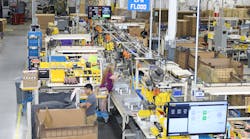"This partnership with industry to produce affordable, efficient lighting will save consumers money and create American jobs," said DOE Secretary Ernest Moniz. "It’s another example of how energy efficiency is a win-win proposition for our economy."
According to a new report by the Energy Department, LED lamps and fixtures installed in US have increased 10-fold over the last two years – from 4.5 million units in 2010 to 49 million units in 2012. These installations, which include common indoor and outdoor applications such as recessed lighting and streetlights, are expected to save about $675 million in annual energy costs. By 2030, LED lighting is projected to represent about 75% of all lighting sales, saving enough energy to power approximately 26 million US households.
Today’s LED lighting is much more efficient than conventional lighting and can last up to 25 times longer. LED life-cycle costs are attractive, but the initial price of LED and OLED lighting is currently higher than the price of traditional lighting. The five projects announced today will help reduce the cost in manufacturing equipment and processes, while improving lighting quality and performance:
Cree Inc., Durham, NC, with a $2.3 million DOE investment, will develop a modular design for LED lights that can link together multiple units to fit larger areas. Cree’s approach will focus on the design and manufacture the different components of an LED fixture as one, seamless product, helping to further reduce assembly costs and ensure strong performance.
Eaton Corporation, Menomonee Falls, WI, with a $2.4 million DOE investment will develop an innovative manufacturing process that streamlines the LED fixture design and removes unnecessary materials and parts. The LED chip can sit directly on the heatsink, improving heat transfer and increasing LED efficiency.
OLEDWorks, LLC, Rochester, NY, with a $1 million DOE investment, will develop and demonstrate new spray printing equipment that reduces overall manufacturing costs in OLEDs and may support cost-competitive mass production. This technique will give manufacturers greater spray control to take full advantage of expensive organic materials and maximize the visible light produced from this material.
Philips Lumileds, San Jose, CA, with a $1.8 million DOE investment, will develop an alternative to the standard flip-chip device that grows an LED face-down on the sapphire substrate. The Philips Lumileds device will treat the sapphire substrate so that the substrate does not need to be removed, which will reduce manufacturing costs without compromising lighting quality.
PPG Industries, Inc., Pittsburgh, PA, with a $2.3 million investment will develop a cost-effective OLED manufacturing process to help commercialize an integrated substrate that includes the glass foundation and other necessary layers. The project will also use standard grade glass, lowering costs while maintaining performance. Commercially-available and low-cost integrated substrates will help build a reliable supply chain.




